'CONFIG
The CONFIG command lets you setup the general system configuration via a GUI dialogue
window operation. It provides a property-sheet like user interface and is divided into
several pages of property-sheet. Each of them can be accessed directly by picking at the
corresponding sheet title on the top of the dialog window. The following sections will
describe them in details.
Paths
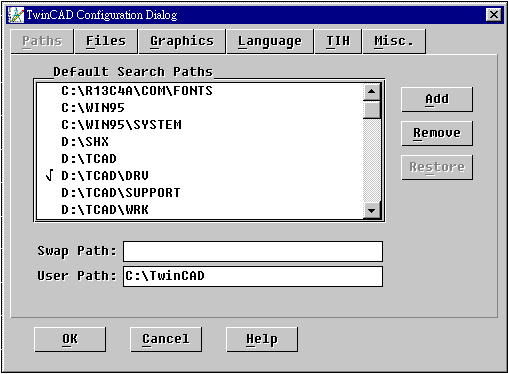
This page setups the following items:
- Default Search Paths
The default search paths are the paths that must be searched through for a missing file
automatically. Whenever TwinCAD fails to open a given file for reading, it will search
through these paths for it. Note that the Windows directory, the Windows system directory,
the directory where TwinCAD resides and all its sub-directories are always default search
paths, regardless of being explicitly specified or not.
You may add new path to the list by pressing the [Add] button and choose the directory
path from the pop-up file window. You may remove existing paths from the list by selecting
them first (pick to select and to un-select) and then pressing the [Remove] button. A
selected path will have a check mark before it. You may press the [Restore] button to
restore the change of the path list.
This item corresponds to the TCADPATH entry from the [General Setup] section in the system
initial file.
- Swap Path The Swap
Path is the path where TwinCAD's virtual memory manager used to swap memory data. The
default will be the root directory of the temporary drive returned by the Windows, which
is usually the the first hard drive in the system.
This item corresponds to the MainSwapPath entry from the [General Setup] section in the
system initial file.
- User Path The User
Path is the path where TwinCAD may use to save and to retrieve specific user data files
(such as these SET files of individual commands). If this path is not given, it defaults
to the current directory, which may be changing and transparent to the user.
This item corresponds to the UserWorkingPath entry from the [General Setup] section in the
system initial file.
Files
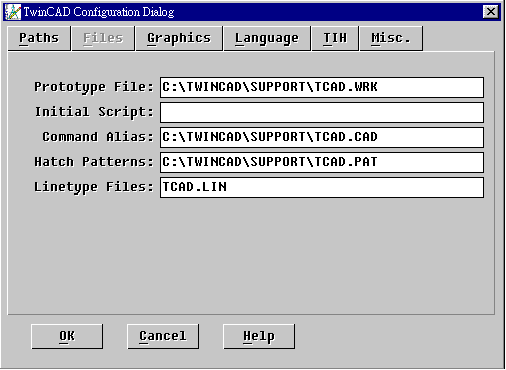
This page setups the following items:
- Prototype File
This item specifies the default prototype drawing file that TwinCAD will load in
automatically in creating a new empty drawing. The internal default is
"TCAD.WRK", if it is not specified.
This item corresponds to the PrototypeWrkFile entry from the [General Setup] section in
the system initial file.
- Initial Script
This item specifies the script file to execute automatically after TwinCAD is started.
There is no default for this item. It corresponds to the InitialScriptFile entry from the
[General Setup] section in the system initial file.
- Command Alias This
item specifies the command alias file to load in after TwinCAD is started. The command
alias file is used to defined alias commands. The default is "TCAD.CAD", if it
is not specified.
This item corresponds to the CommandAliasFile entry from the [General Setup] section in
the system initial file.
- Hatch Patterns
This item specifies the hatch pattern definition file to load in after TwinCAD is started.
The hatch pattern definition file is used to stored predefined hatch patterns. The default
is "TCAD.PAT", if it is not specified.
This item corresponds to the HatchPatternFile entry from the [General Setup] section in
the system initial file.
- Linetype File This
item specifies the linetype definition file to load in after TwinCAD is started. The
linetype definition file is used to stored predefined linetypes. The default is
"TCAD.LIN", if it is not specified.
This item corresponds to the ExtLinetypeFile entry from the [General Setup] section in the
system initial file.
Graphics
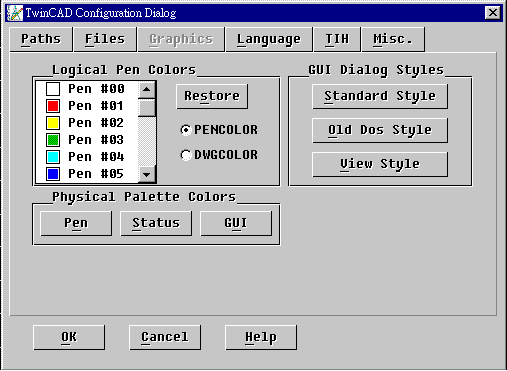
This page setups graphic related configuration.
Logical Pen Colors
The logical pen colors group setups the 16 logical drawing pen's color from pen color 0
to pen color 15. There are two set of such drawing pen color assignment:
- PenColor The
native drawing pen color setup for TwinCAD. TwinCAD does not regulate the actual color
used for each pen color number. However, a default assignment has been given since its DOS
release. It is recommended now that this should be set to be compatible with the DWG file
specification.
- DWGColor This is
the pen color set for DWG file compatibility. TwinCAD will automatically switch to use
this pen color set whenever a DWG file is loaded.
You can choose to setup either one of the above two sets of logical pen color
assignments by selecting on their corresponding radio buttons.
To change a specific logical pen color assignment, pick at the pen from the list box
directly. A logical pen color assignment dialog window will pop up for you to choose for
the new pen color. You can choose it from the 16 physical pen colors, of which the actual
colors are setup separately.
Physical Palette Colors
There are three buttons in this group.
- Pen Press this
button to setup the physical pen colors used in the drawing. The physical pen color is the
palette color used by TwinCAD to realize the drawing's logical pen. Currently, only 16
palette colors are supported. TwinCAD uses the physical palette color index 0 as the
drawing's background in the screen. So, change palette color index 0, will change the
drawing's background after drawing refresh or regeneration.
- Status Press this
button to setup the physical palette colors used in drawing status display, such as the
object hight-light, various kind of cursors and status icons.
- GUI Press this
button to setup the physical palette colors used in the GUI elements created by TCL
runtime functions as well as those created by the TwinCAD commands that are compatible
with its DOS counterpart. A special window class called TCAMGUI is implemented in TwinCAD
to simulate the TCAM GUI used in its DOS counterpart. The TCAMGUI assumes the display is a
standard VGA using 16 color palettes.
A physical palette color setup dialog window will pop up when you press either one of
the above two buttons.
GUI Dialog Style
There are three buttons in this groups:
- Standard Style
Press this button and all the dialog windows created by TwinCAD commands will be in gray
background.
- Old Dos Style
Press this button and all the dialog windows created by TwinCAD commands will be in
colorful background as those in its DOS counterpart.
- View Style Press
this button to see an example of the dialog window.
The size, location and color attributes of each dialog window created by TwinCAD
command is stored in the system initial file. The above function actually modifies these
setups. Note that once the style is changed, it can not be restored by pressing the main
[Cancel] button.
Language
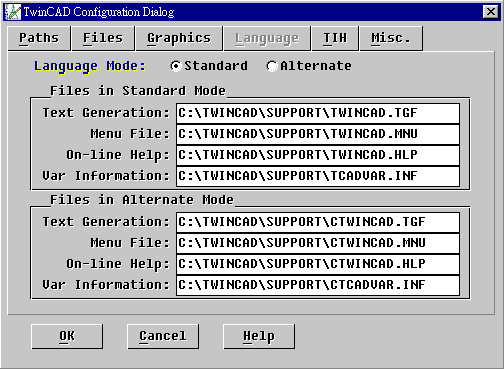
Although its DOS version counterpart of TwinCAD supports multi-lingual operating
environments, TwinCAD is basically a bilingual CAD system for Windows in that it supports
a SWITCH command that can be issued at anytime to switch the operating environment between
the two different language modes.
The two language modes supported in TwinCAD are
- Standard Mode
English language.
- Alternative Mode Local
language supported by Windows.
There are several language dependent files need to be specified in both modes:
- Text Generation File System
message text generation file.
- Menu File The
current default menu file. This setting will be modified automatically by MENU command.
- On-line Help The
help file invoked by HELP command.
- Var Information
Variable information file. A simple text file containing short description to system
variable, used in SYSVAR, DIMVAR and STYLE commands.
For each of the above entry, TwinCAD will have a default setting internally according
to the Windows language version:
- Standard Mode, English
"TWINCAD.TGF", "TWINCAD.MNU", "TWINCAD.HLP",
"TWINCAD.VAR".
- Traditional Chinese
"CTWINCAD.TGF", "CTWINCAD.MNU", "CTWINCAD.HLP",
"CTWINCAD.VAR".
- Simplified Chinese
"BTWINCAD.TGF", "BTWINCAD.MNU", "BTWINCAD.HLP",
"BTWINCAD.VAR".
- Japanese
"JTWINCAD.TGF", "JTWINCAD.MNU", "JTWINCAD.HLP",
"JTWINCAD.VAR".
- Korean
"KTWINCAD.TGF", "KTWINCAD.MNU", "KTWINCAD.HLP",
"KTWINCAD.VAR".
- Thai
"TTWINCAD.TGF", "TTWINCAD.MNU", "TTWINCAD.HLP",
"TTWINCAD.VAR".
- Others "TWINCAD.TGF",
"TWINCAD.MNU", "TWINCAD.HLP", "TWINCAD.VAR".
TIH (Text Input Handler)
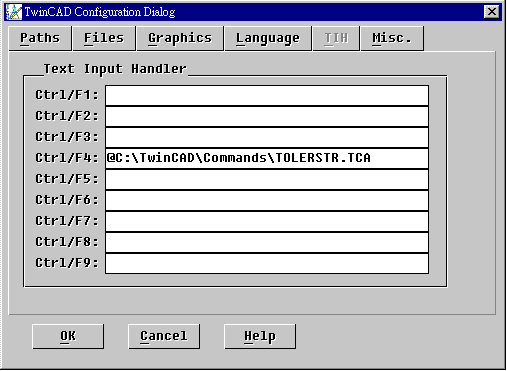
This page setups the text input handler associated with each <Ctrl/Fn> key.
Currently available text input handler in TCL program is the "TOLERSTR.TCL" for
tolerance expression input. You may assign it to <Ctrl/F4> for DOS version
compatibility. See TEXT command for further details.
Misc. (Miscellaneous)
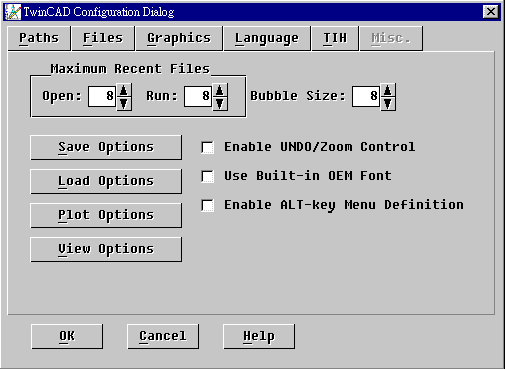
Maximum Recent Files
TwinCAD currently supports two MRU (Most Recently Used) lists in the menu. You may
specify the maximum number of entries allowed for each list from the Maximum Recent Files
group:
- Open This value
entry specifies the maximum entries in $OPEN list, which saves the most recent open
drawing files.
- Run This value
entry specifies the maximum entries in $RUN list, which saves the most recent executed TCL
program files.
Bubble Size
This is a value entry specifying the logical font size used for the bubble text
(helping text in a pop-up tiny window with yellow background). If it is 0, then the
current Windows system default font and size will be used. Otherwise, the font name will
always be "MS Sans Serif".
If the font size is positive, TwinCAD will check the Windows language version and
specify the local language character set to use for the font. If the font size is
negative, it specifies ANSI set. The actual font used will be determined by the Windows
Font Mapper.
This item corresponds to the BubbleFontSize entry from the [General Setup] section in
the system initial file.
Enable Undo/Zoom Control
This is an option check box control. If this option is enabled, the change of the
screen drawing view (via ZOOM/PAN commands) will be included in the UNDO/
REDO mechanism. Note that the change of drawing view has its own undo/redo mechanism
(via ZP/ZN commands).
Use Built-in OEM Font
This is an option check box control. If this option is enabled, TwinCAD will use its
internal built-in bitmap font to display IBM-extended Ascii characters. It this option is
not enabled, TwinCAD will use Windows OEM font for the message text display. Note that
TwinCAD will always use built-in bitmap font under NT machine, despite of this setting.
If you have problem with the message text display using the IBM-extended ascii
character set in TwinCAD, you should make a check on this option. Some language version of
Windows does not support the IBM-extended ascii character set in its system OEM font.
Enable Alt-key Menu Definition
This is an option check box control. If this option is enabled, the Alt-Key definition
from the menu file will be valid and override the short-cut key in the pop-up menu
invocation. Otherwise, the Alt-key definition from the current loaded menu file will be
ineffective.
Miscellaneous Option Setup Buttons
There are several option setup buttons in this page that invoke other independent
option setup dialog.
- Save Option This
button invokes the SAVEOPT command to setup the drawing saving related options. See
SAVEOPT command for details.
- Load Option This
button invokes the LOADOPT command to setup the drawing loading related options. See
LOADOPT command for details.
- Plot Option This
button invokes the PLOTOPT command to setup the printing/ploting related options. See
PLOTOPT command for details.
- View Option This
button invokes the VIEWOPT command to setup the screen drawing view related options. See
VIEWOPT command for details.
Note that the setup operation from these above option button can not be canceled by the
main [Cancel] button.
Other Buttons
Except noted otherwise, after completing all the setup operation, you will have to
press the [OK] button to confirm the change and terminate CONFIG to make them become
effective. Or, you may press the [Cancel] to quit CONFIG operation. You may also press
<ESC> key or the right mouse button to quit the operation.
Special Notes:
The CONFIG command is an external command provided by the TCL program file
"CONFIG.TCL" or "CONFIG.TCA". Either file must be present in the
COMMANDS sub-directory where the TwinCAD resides. If you can not issue CONFIG command, you
may solve the problem by copying the "CONFIG.TCL" or "CONFIG.TCA" to
the COMMANDS sub-directory.
|





